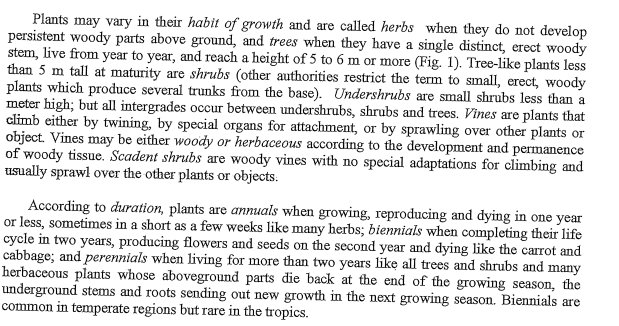Biology: The Dynamic Science (MindTap Course List)
4th Edition
ISBN:9781305389892
Author:Peter J. Russell, Paul E. Hertz, Beverly McMillan
Publisher:Peter J. Russell, Paul E. Hertz, Beverly McMillan
Chapter36: Reproduction And Development In Flowering Plants
Section: Chapter Questions
Problem 1ITD
Related questions
Question
What is the habit growth of potato, onion, turnip, carrots, and ginger?

Transcribed Image Text:Plants may vary in their habit of growth and are called herbs when they do not develop
persistent woody parts above ground, and trees when they have a single distinct, erect woody
stem, live from year to year, and reach a height of 5 to 6 m or more (Fig. 1). Tree-like plants less
than 5 m tall at maturity are shrubs (other authorities restrict the term to small, erect, woody
plants which produce several trunks from the base). Undershrubs are small shrubs less than a
meter high; but all intergrades occur between undershrubs, shrubs and trees. Vines are plants that
climb either by twining, by special organs for attachment, or by sprawling over other plants or
object. Vines may be either woody or herbaceous according to the development and permanence
of woody tissue. Scadent shrubs are woody vines with no special adaptations for climbing and
usually sprawl over the other plants or objects.
According to duration, plants are annuals when growing, reproducing and dying in one year
or less, sometimes in a short as a few weeks like many herbs; biennials when completing their life
cycle in two years, producing flowers and seeds on the second year and dying like the carrot and
cabbage; and perennials when living for more than two years like all trees and shrubs and many
herbaceous plants whose aboveground parts die back at the end of the growing season, the
underground stems and roots sending out new growth in the next growing season. Biennials are
common in temperate regions but rare in the tropics.
Expert Solution
This question has been solved!
Explore an expertly crafted, step-by-step solution for a thorough understanding of key concepts.
Step by step
Solved in 2 steps

Knowledge Booster
Learn more about
Need a deep-dive on the concept behind this application? Look no further. Learn more about this topic, biology and related others by exploring similar questions and additional content below.Recommended textbooks for you

Biology: The Dynamic Science (MindTap Course List)
Biology
ISBN:
9781305389892
Author:
Peter J. Russell, Paul E. Hertz, Beverly McMillan
Publisher:
Cengage Learning

Biology (MindTap Course List)
Biology
ISBN:
9781337392938
Author:
Eldra Solomon, Charles Martin, Diana W. Martin, Linda R. Berg
Publisher:
Cengage Learning


Biology: The Dynamic Science (MindTap Course List)
Biology
ISBN:
9781305389892
Author:
Peter J. Russell, Paul E. Hertz, Beverly McMillan
Publisher:
Cengage Learning

Biology (MindTap Course List)
Biology
ISBN:
9781337392938
Author:
Eldra Solomon, Charles Martin, Diana W. Martin, Linda R. Berg
Publisher:
Cengage Learning
